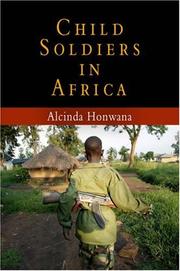| Listing 1 - 5 of 5 |
Sort by
|
Book
ISBN: 9780230241961 Year: 2011 Publisher: Houndmills, UK : Palgrave MacMillan,
Abstract | Keywords | Export | Availability | Bookmark
 Loading...
Loading...Choose an application
- Reference Manager
- EndNote
- RefWorks (Direct export to RefWorks)
CHILD SOLDIERS --- CHILD SOLDIERS--REHABILITATION --- CHILDREN AND WAR
Book
ISBN: 9781349324408 9780230307698 Year: 2011 Publisher: Houndmills Palgrave Macmillan
Abstract | Keywords | Export | Availability | Bookmark
 Loading...
Loading...Choose an application
- Reference Manager
- EndNote
- RefWorks (Direct export to RefWorks)
Violence, conflict, and war challenge everyday understandings about the 'nature' of children and boundaries of childhood. In the disruption and destruction of the lives of children, their families and communities, childhood itself transforms and takes shape. Children, like others, are both subject to the consequences of war and actively involved in many aspects of conflict. They are and have been fighters, victims, refugees, peace-builders and reasons both to enter into and to end wars. Children and Armed Conflict explores the multi-faceted ways in which children have encountered armed conflict, illuminating their varied historical and contemporary roles. This book moves beyond the child simply as either 'victim' or 'soldier' by examining children's experiences of armed conflict in their broader historical, sociological, anthropological, literary, cultural, psychological, and public policy complexities. -- Back cover.
Children and war --- War --- Psychic trauma in children --- Psychological aspects
Book
ISBN: 0771051476 1299168809 Year: 2011 Publisher: [Place of publication not identified] Signal
Abstract | Keywords | Export | Availability | Bookmark
 Loading...
Loading...Choose an application
- Reference Manager
- EndNote
- RefWorks (Direct export to RefWorks)
Children and war --- Women and war --- War victims --- Humanitarian assistance
Book
ISBN: 9781433103827 1433103826 Year: 2011 Publisher: New York : Peter Lang,
Abstract | Keywords | Export | Availability | Bookmark
 Loading...
Loading...Choose an application
- Reference Manager
- EndNote
- RefWorks (Direct export to RefWorks)
"We have often ignored the wartime contributions of children. What were they expected to do? How did it contribute to the war? How did it affect their lives? This history attempts to respond to these questions, by examining activities of children in the United States during World Wars I and II. Modern propaganda helped to draw children into those wars. A variety of authorities participated, in the school, on the playground, at work or at home. They promoted military ideals and activities in hopes these might reduce fear, build character, prepare for service, and even tangibly help the war effort. In doing so, authorities brought war themes to children on a day to day basis, a militarization of American childhood. This research takes a look at how they did that"--Preface.
Children and war --- Propaganda, American --- Enfants et guerre --- Propagande américaine --- History --- Histoire

ISBN: 0812204778 0812219872 1283212277 9786613212276 9781283212274 9780812204773 Year: 2011 Publisher: Philadelphia : University of Pennsylvania Press,
Abstract | Keywords | Export | Availability | Bookmark
 Loading...
Loading...Choose an application
- Reference Manager
- EndNote
- RefWorks (Direct export to RefWorks)
Young people have been at the forefront of political conflict in many parts of the world, even when it has turned violent. In some of those situations, for a variety of reasons, including coercion, poverty, or the seductive nature of violence, children become killers before they are able to grasp the fundamentals of morality. It has been only in the past ten years that this component of warfare has captured the attention of the world. Images of boys carrying guns and ammunition are now commonplace as they flash across television screens and appear on the front pages of newspapers. Less often, but equally disturbingly, stories of girls pressed into the service of militias surface in the media.A major concern today is how to reverse the damage done to the thousands of children who have become not only victims but also agents of wartime atrocities. In Child Soldiers in Africa, Alcinda Honwana draws on her firsthand experience with children of Angola and Mozambique, as well as her study of the phenomenon for the United Nations and the Social Science Research Council, to shed light on how children are recruited, what they encounter, and how they come to terms with what they have done. Honwana looks at the role of local communities in healing and rebuilding the lives of these children. She also examines the efforts undertaken by international organizations to support these wartime casualties and enlightens the reader on the obstacles faced by such organizations.
Child soldiers --- Children and war --- Children and violence --- Political violence --- Anthropology. --- Folklore. --- General. --- Human Rights. --- Law. --- Linguistics. --- Social Science.
| Listing 1 - 5 of 5 |
Sort by
|

 Search
Search Feedback
Feedback About UniCat
About UniCat  Help
Help News
News